View in other NatureServe Network Field Guides
NatureServe
Montana
Utah
Wyoming
Idaho
Wisconsin
British Columbia
South Carolina
Yukon
California
New York
California Tortoiseshell - Nymphalis californica
Native Species
Global Rank:
G5
State Rank:
S5
Agency Status
USFWS:
USFS:
BLM:
External Links
General Description
[From Ferris and Brown 1981, Scott 1986, Glasberg 2001, Guppy and Shepard 2001, Pyle 202] Forewings 2.5-3.0 cm. Rich brown-orange over most of dorsal surface, with yellow highlights and black spots and patches; wing margins hoary, black border has short rounded tails on hindwings, dorsal hindwing clear orange with black spot on leading edge but no prominent white bar; ventral surface bark-brown with striations and variable white marbling, lighter outward and darker toward the wing base. Forelegs of male hairier than those of female.
Phenology
Varies. One flight in Colorado, adults active July to October when they hibernate (Ferris and Brown 1981). Three or more flights in California; adults emerge from hibernation in February to early April, produce the first flight in late May to early June, second flight July-August, third flight in late September to October (Scott 1986). In Washington and Oregon, late January to mid-November, with peaks in April and August related to different cohorts (Pyle 2002).
Diagnostic Characteristics
Most similar to Compton Tortoiseshell (Nymphalis vaualbum), but lacks a white bar on dorsal hindwing, has a black dorsal hindwing margin, and is more heavily marked dorsally with bright orange.
Species Range
Montana Range
Range Descriptions
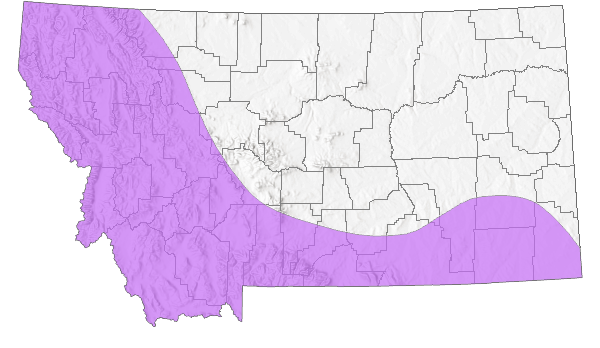
 Native
Native
Range Comments
From British Columbia south along the Pacific Coast to northern Baja California, east regularly to Montana, Wyoming, Colorado, and New Mexico west of the Great Plains. Migrant outbreaks reach east across southern Canada to Michigan, Pennsylvania, New York, and Vermont (Scott 1986, Guppy and Shepard 2001). Regular in the lower montane portions of the western third of Montana (Kohler 1980, Stanford and Opler 1993). Usually rare to uncommon, but abundant during outbreak years (Glassberg 2001); rarity or absence in British Columbia in some years suggests migrants required to maintain British Columbia populations (Guppy and Shepard 2001).
Observations in Montana Natural Heritage Program Database
Number of Observations: 311
(Click on the following maps and charts to see full sized version)
Map Help and Descriptions
Relative Density
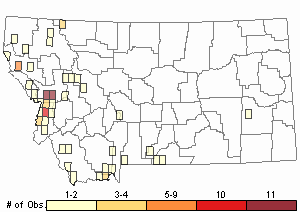
Recency
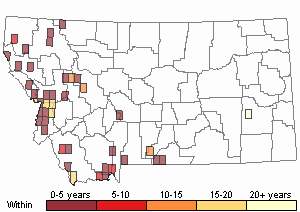
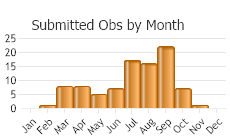
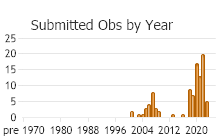
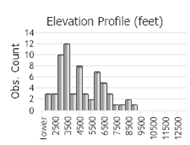 (Observations spanning multiple months or years are excluded from time charts)
(Observations spanning multiple months or years are excluded from time charts)
Migration
Migratory, with large immigrant influxes from multiple flights some years (Scott 1986, Guppy and Shepard 2001, Pyle 2002). Migrates north and east in May in central California, south and west in September and October, although early and late migrations comprised of individuals in different cohorts (Shapiro 1975).
Habitat
Lower montane chaparral, canyon bottoms, ponderosa pine woodland clearings and trails, but almost any habitat during irruption years, including urban areas and above treeline in alpine terrain (Knaus and Lambremont 1987, Shields 1987, Pyle 2002, Hendricks 2005); reported in alpine terrain in Glacier National Park (Debinski 1993).
Food Habits
Larval food plants include several species of Ceanothus (Scott 1986, Pyle 2002). Adults feed on flower nectar, sap, fruit, and mud.
Reproductive Characteristics
Overwinters (hibernates) as adult. Females deposit eggs on the underside of leaves, sometimes in small clusters. Eggs hatch in 4-5 days. Development rapid at certain temperatures, pupation 25-27 days after eggs hatch, with 5, 3, 4, 5, and 10 days spent in L1, L2, L3, L4, and L5 instars, respectively. Adults emerge from pupae in 6-11 days, about 5 weeks after oviposition. Larvae do not make nests, but early instars may cover themselves by joining leaves together; larvae feed openly on vegetation (James and Nunnallee 2011). Adult males perch during mid-day to late afternoon on branches in valley bottoms to await passing females (Scott 1986).
Stewardship Responsibility
References
- Literature Cited AboveLegend:
 View Online Publication
View Online Publication Debinski, D. 1993. Butterflies of Glacier National Park, Montana. Occasional Papers of the Museum of Natural History, the University of Kansas, Lawrence, Kansas. No. 159: 1-13.
Debinski, D. 1993. Butterflies of Glacier National Park, Montana. Occasional Papers of the Museum of Natural History, the University of Kansas, Lawrence, Kansas. No. 159: 1-13. Ferris, C.D. and F.M. Brown (eds). 1981. Butterflies of the Rocky Mountains. Univ. of Oklahoma Press. Norman. 442 pp.
Ferris, C.D. and F.M. Brown (eds). 1981. Butterflies of the Rocky Mountains. Univ. of Oklahoma Press. Norman. 442 pp. Glassberg, J. 2001. Butterflies through Binoculars: A Field Guide to the Butterflies of Western North America. Oxford University Press.
Glassberg, J. 2001. Butterflies through Binoculars: A Field Guide to the Butterflies of Western North America. Oxford University Press. Guppy, C.S. and J.H. Shepard. 2001. Butterflies of British Columbia: including western Alberta, southern Yukon, the Alaska Panhandle, Washington, northern Oregon, northern Idaho, northwestern Montana. UBC Press (Vancouver, BC) and Royal British Columbia Museum (Victoria, BC). 414 pp.
Guppy, C.S. and J.H. Shepard. 2001. Butterflies of British Columbia: including western Alberta, southern Yukon, the Alaska Panhandle, Washington, northern Oregon, northern Idaho, northwestern Montana. UBC Press (Vancouver, BC) and Royal British Columbia Museum (Victoria, BC). 414 pp. Hendricks, P. 2005. Common Ravens capturing adult California Tortoiseshell butterflies. Northwestern Naturalist 86:81-82.
Hendricks, P. 2005. Common Ravens capturing adult California Tortoiseshell butterflies. Northwestern Naturalist 86:81-82. James, D.G. and D. Nunnallee. 2011. Life histories of Cascadia butterflies. Corvallis, OR: Oregon State University Press. 447 p.
James, D.G. and D. Nunnallee. 2011. Life histories of Cascadia butterflies. Corvallis, OR: Oregon State University Press. 447 p. Knaus, R.M. and E.N. Lambremont. 1987. A migratory flight of the California Tortoise-shell butterfly. Journal of the Lepidopterists' Society 41:121-122.
Knaus, R.M. and E.N. Lambremont. 1987. A migratory flight of the California Tortoise-shell butterfly. Journal of the Lepidopterists' Society 41:121-122. Kohler, S. 1980. Checklist of Montana Butterflies (Rhopalocera). Journal of the Lepidopterists' Society 34(1): 1-19.
Kohler, S. 1980. Checklist of Montana Butterflies (Rhopalocera). Journal of the Lepidopterists' Society 34(1): 1-19. Pyle, R.M. 2002. The butterflies of Cascadia: a field guide to all the species of Washington, Oregon, and surrounding territories. Seattle Audubon Society, Seattle, Washington. 420 pp.
Pyle, R.M. 2002. The butterflies of Cascadia: a field guide to all the species of Washington, Oregon, and surrounding territories. Seattle Audubon Society, Seattle, Washington. 420 pp. Scott, J.A. 1986. The butterflies of North America: a natural history and field guide. Stanford University Press, Stanford, California.
Scott, J.A. 1986. The butterflies of North America: a natural history and field guide. Stanford University Press, Stanford, California. Shapiro, A.M. 1975. Why do California Tortoiseshells migrate? Journal of Research on the Lepidoptera 14:93-97.
Shapiro, A.M. 1975. Why do California Tortoiseshells migrate? Journal of Research on the Lepidoptera 14:93-97. Shields, O. 1987. Two related migrations of the California Tortoise-shell butterfly in Mariposa County, California, in 1986. Journal of the Lepidopterists' Society
Shields, O. 1987. Two related migrations of the California Tortoise-shell butterfly in Mariposa County, California, in 1986. Journal of the Lepidopterists' Society Stanford, R.E. and P.A. Opler. 1993. Atlas of western USA butterflies: including adjacent parts of Canada and Mexico. Unpubl. Report. Denver and Fort Collins, Colorado 275 pp.
Stanford, R.E. and P.A. Opler. 1993. Atlas of western USA butterflies: including adjacent parts of Canada and Mexico. Unpubl. Report. Denver and Fort Collins, Colorado 275 pp.
- Additional ReferencesLegend:
 View Online Publication
View Online Publication
Do you know of a citation we're missing? Allen, T.J., J.P. Brock, and J. Glassberg. 2005. Caterpillars in the field and garden: a field guide to the butterfly caterpillars of North America. Oxford University Press.
Allen, T.J., J.P. Brock, and J. Glassberg. 2005. Caterpillars in the field and garden: a field guide to the butterfly caterpillars of North America. Oxford University Press. Bird, C.D., G.I. Hilchie, N.G. Kondla, E.M. Pike, and F.A.H. Sperling. 1995. Alberta Butterflies. The Provincial Museum of Alberta, Edmonton. 349 pp.
Bird, C.D., G.I. Hilchie, N.G. Kondla, E.M. Pike, and F.A.H. Sperling. 1995. Alberta Butterflies. The Provincial Museum of Alberta, Edmonton. 349 pp. Brock, J.P. and K. Kaufman. 2003. Kaufman Field Guide to Butterflies of North America. Houghton Mifflin Company, New York, NY 284 pp.
Brock, J.P. and K. Kaufman. 2003. Kaufman Field Guide to Butterflies of North America. Houghton Mifflin Company, New York, NY 284 pp. Caruthers, J.C., and D. Debinski. 2006. Montane meadow butterfly species distributions in the Greater Yellowstone Ecosystem. University of Wyoming National Park Service Research Center Annual Report, 2006. Vol. 30, Art. 14. 85-96.
Caruthers, J.C., and D. Debinski. 2006. Montane meadow butterfly species distributions in the Greater Yellowstone Ecosystem. University of Wyoming National Park Service Research Center Annual Report, 2006. Vol. 30, Art. 14. 85-96. Forister, M.L., C.A. Halsch, C.C. Nice, J.A. Fordyce, T.E. Dilts, J.C. Oliver, K.L. Prudic, A.M. Shapiro, J.K. Wilson, J. Glassberg. 2021. Fewer butterflies seen by community scientists across the warming and drying landscapes of the American West. Science 371:1042-1045.
Forister, M.L., C.A. Halsch, C.C. Nice, J.A. Fordyce, T.E. Dilts, J.C. Oliver, K.L. Prudic, A.M. Shapiro, J.K. Wilson, J. Glassberg. 2021. Fewer butterflies seen by community scientists across the warming and drying landscapes of the American West. Science 371:1042-1045. Forister, M.L., E.M. Grames, C.A. Halsch, K.J. Burls, C.F. Carroll, K.L. Bell, J.P. Jahner, et al. 2023. Assessing risk for butterflies in the context of climate change, demographic uncertainty, and heterogeneous data sources. Ecological Monographs 93(3):e1584. https://doi.org/10.1002/ecm.1584
Forister, M.L., E.M. Grames, C.A. Halsch, K.J. Burls, C.F. Carroll, K.L. Bell, J.P. Jahner, et al. 2023. Assessing risk for butterflies in the context of climate change, demographic uncertainty, and heterogeneous data sources. Ecological Monographs 93(3):e1584. https://doi.org/10.1002/ecm.1584 Layberry, R.A., P.W. Hall, and J.D. LaFontaine. 1998. The Butterflies of Canada. University of Toronto Press. 280 pp. + color plates.
Layberry, R.A., P.W. Hall, and J.D. LaFontaine. 1998. The Butterflies of Canada. University of Toronto Press. 280 pp. + color plates. Maxell, B.A. 2016. Northern Goshawk surveys on the Beartooth, Ashland, and Sioux Districts of the Custer-Gallatin National Forest: 2012-2014. Montana Natural Heritage Program. Helena, MT. 114pp.
Maxell, B.A. 2016. Northern Goshawk surveys on the Beartooth, Ashland, and Sioux Districts of the Custer-Gallatin National Forest: 2012-2014. Montana Natural Heritage Program. Helena, MT. 114pp. Opler, P.A., K. Lotts, and T. Naberhaus, coordinators. 2010. Butterflies and moths of North America. Big Sky Institute, Bozeman, MT. Available at: www.butterfliesandmoths.org (Accessed 15 June 2015).
Opler, P.A., K. Lotts, and T. Naberhaus, coordinators. 2010. Butterflies and moths of North America. Big Sky Institute, Bozeman, MT. Available at: www.butterfliesandmoths.org (Accessed 15 June 2015).
- Web Search Engines for Articles on "California Tortoiseshell"
- Additional Sources of Information Related to "Insects"





